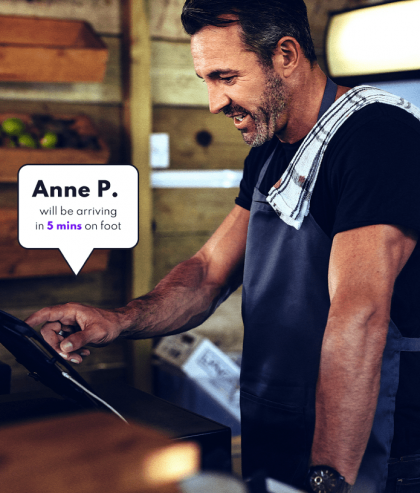GEOFENCING EXPLAINED
What Is Geofencing? Everything You Need to Know
What is Geofencing?
Geofences help mobile marketers understand their customers’ behaviors in the physical world.
A geofence is a virtual perimeter around a specific location that measures when someone with a mobile device enters or exits the digital boundary in the physical world. These digital boundaries are typically pre-defined by marketers and mobile product owners through geofencing software.
Once a customer crosses the virtual perimeter, this information, usually called location data, can then be used to send real-time push messages to their device or used later for more timely, personalized experiences.
Who Are Geofences Valuable For?
Geofencing software is often critical to app acquisition, engagement, and retention.
Location-based campaigns that deliver immediate value to users can significantly boost app downloads. For example, a quick-service restaurant might offer a discounted or free item when the user downloads the app and visits one of their stores to ‘unlock’ the offer.
Product managers can increase engagement by knowing when they have a captive audience. For example, product managers of airline apps might send a survey prompt when a customer lands and is waiting to deplane.
Restaurant apps with mobile ordering can provide fresher food and faster service to customers by setting concentric geofences around the store (see image on the left) and sequencing orders based on customers’ estimated time of arrival.
Product and app managers can also identify when they’ve lost a customer to a competitor by setting geofences around competitor locations—thus detecting when a loyal customer visits their store. This rich insight is valuable for determining when customers are most likely to churn and what products/features might win them back.
90%Pew Research Center, 2020
of users utilized location-based services on their smartphones in 2019
Geofencing software powers everything from playing Pokemon Go to finding a ride across town. Consider how essential location is to daily activities such as:
- Avoiding traffic congestion on our morning commute
- Automatically triggering rewards points at our favorite coffee shop
- Mobile shopping with curbside pickup or in-store pick up
- Ordering pizza delivery to a park on a sunny day
- Checking train and bus schedules without having to manually type in our current location
The list continues as the value of geofence-enabled experiences varies based on each person’s favorite app or lifestyle. It’s no surprise then, the location-based tech market is expected to grow at a Compound Annual Growth Rate (CAGR) of 27.1% by 2026.Allied Market Research, 2019
89%Statista, 2020
of marketers emphasize sales as the number one advantage of using location-based mobile marketing
Geofences can power relevant, beneficial messaging and frictionless experiences for customers.
Marketers use geofences to understand how to engage customers. They help marketers create omnichannel engagement strategies that cater to their customers’ preferred messaging channels based on their real-world behaviors.
For instance, sending an email is a highly effective way of reaching customers, but less effective than making a connection while they’re waiting for their curbside delivery outside a store, or redeeming loyalty points at a restaurant drive-thru.
Marketers also use geofences to know when to engage their customers in real-time, when the experience can be best enhanced.
Does Geofencing Require an App?
Not always.
Geofences can be used without an app by obtaining customers’ latitude/longitude or zip codes from digital ad networks. Another alternative is getting mobile location data from telecommunications providers based on cell tower signals. Using geofences without an app provides only the general area of a customer (i.e. it’s highly inaccurate) and offers limited aggregated trends (e.g. people in this zip code typically do XYZ).
Some location providers might also offer an algorithm of various geo-spacial data points to determine the likelihood of a person crossing a general geofenced area. This information is best used for general marketing purposes.
Geofences used with mobile apps offer a couple of different options. Mobile operating systems (OS) have location services by default that marketers can use for geofencing. However, the native OS geofencing has limitations.
Another option for geofencing with an app is to use proprietary location technology (typically an SDK that gets embedded into the brand’s app). This option opens a whole new world of possibility because proprietary geofencing software has the potential to accurately determine if a person has entered or exited the geofence. For example, a brand can detect when a customer enters their store or parking lot via their app to deliver timely reminders (such as loyalty card prompts) or effortless experiences (automated check-ins for mobile orders).
Curious how to choose a geofencing solution with all the right features?


How Accurate Is Geofencing?
Knowing with moderate confidence that a customer is in a general 150-meter area is much less useful than knowing they’ve just entered your store. This is why location accuracy matters. For location data to be actionable, marketers need accurate geofencing.
Real accuracy requires a combination of signals including GPS, WiFi, and/or Bluetooth beacons. When the location settings are turned on, the mobile app picks up these signals. Accurately detecting location signals depends on the technology used.
Native Geofencing Software
App developers can use native Android and iOS location detection to power their location-based experiences and engagement. However, native geofencing technology can only deliver accuracy of around 100-200 meters. For context, that’s about the length of a soccer field. This can work for general location-based marketing — use cases that don’t require accuracy.
For example, brands can detect when their customers are somewhere nearby and prompt them to use their loyalty card, but the customer might be shopping at a different store around the block. A lack of geofencing accuracy can lead brands to send poorly timed and irrelevant messages — risking revoked location permissions or worse, app churn.
Native geofencing has other limitations such as the number of geofences, the shape of geofences (circular only), and significant battery drain when using maximum accuracy.
Proprietary Geofencing Software
Proprietary geofencing software has the capacity to deliver accuracy down to 10 meters, or roughly the size of a soccer goal. It can also allow app developers to create multi-sided geofences for specific use cases (e.g. a parking spot, drive-thru lane, unique building shape, etc.).
This level of accuracy and flexibility is essential for powering use cases such as detecting which lane a vehicle is in at a toll or distinguishing between drive-thru and walk-in traffic. Knowing that a customer has entered a narrow, custom shaped geofence (such as a brand’s store within a shopping center) means brands can automate check-ins for mobile orders because they can detect when a customer walks into the store.
Advantages of Proprietary Geofencing Software
Proprietary geofencing supports high-value, high-accuracy use cases that may require complex configurations. Some businesses, like tolling apps, need a single line or series of lines (instead of a shape) to accurately detect both the direction and speed of a car. Or consider a quick-service restaurant that may need custom geofence shapes to map out their drive-thru.
For scaling your geofence strategy to many locations, your proprietary location provider can programmatically geofence millions of points of interest (POI) such as gyms, parks, and shoe stores on a local or international level. For example, geofencing every coffee shop in the United States could be done in a matter of days.
How to Set Up Geofences
Native Geofencing Software
If you’re thinking about using native geofencing technology (iOS or Android operating system), you’ll need to allocate considerable resources on development. Keep in mind this solution provides only minimal accuracy for use cases.
Technical expertise will be required for creating geofences and making any ongoing adjustments.
Proprietary Geofencing Software
If you decide to work with a proprietary geofencing service provider, you will have access to out-of-the-box functionality via an SDK. This provides more efficient deployment and conserves valuable engineering resources. Creating geofences can be as easy as drawing a circle, square, line, or polygon on a map.
Anyone can create the geofences using a map-based UI.
I’ve Created
My Geofences –
Now What?
Welcome to a world of possibility.
For more ideas on how geofences can deliver value to your customers and boost app retention, explore our Location Solution Guide. Ideas inside.